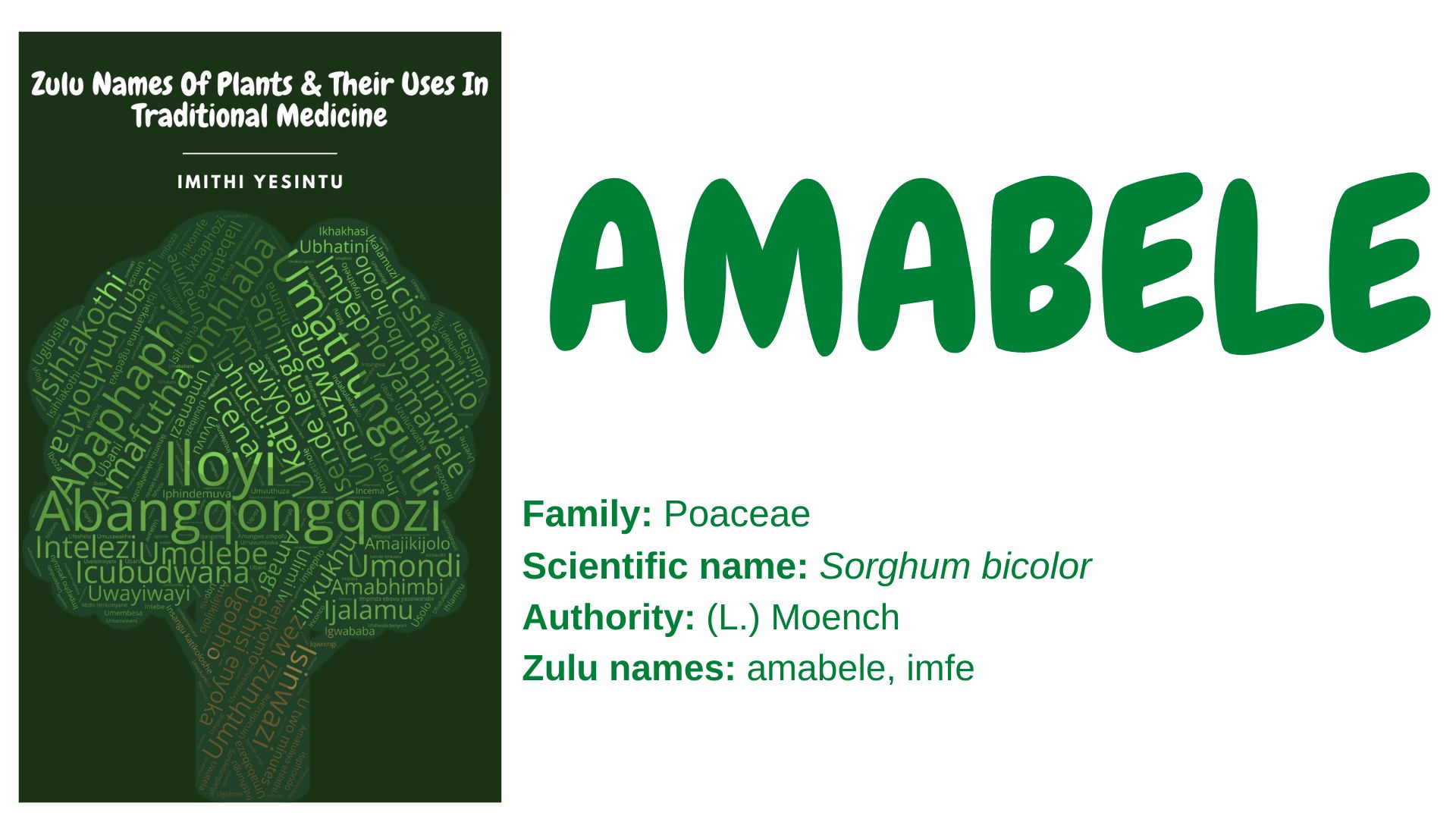Family: Poaceae
Scientific name: Sorghum bicolor
Authority: (L.) Moench
Synonyms: Sorghum saccharatum (L.) Moench, Sorghum sorghum (L.) H.Karst.
Zulu names: amabele, imfe
Other names: broom corn, corn, kaffir corn, red kaffir, shallu, sugar millet, sugar reed, sweet cane, sweet reed, sweet sorghum (English) anaguaskoorn, besemkoring kafferkoring, rooikafferkoring, graansorghum, soetriet, suikerriet, wilde (Afrikaans)
Description: S. bicolor is a strong perennial or annual grass with broad and long leaves that are coated with white wax, small flowers in clusters, and edible seeds in a spike. The grass can grow in a variety of soils, it is drought-tolerant and grows in poor soils.
When young the plant is poisonous, containing hydrogen cyanide, which is destroyed after drying.
Uses:
- The grain is used for food for feeding humans and animals.
- The grain is used to make alcoholic beverages.
- The grain is used to make edible oil and biofuel.
- The grain is used to produce fibre.
- The seeds are used to make a decoction that is used as diuretic, demulcent, and emollient.
- The seed decoction is used to improve digestion, treat cancer, and epilepsy.
- The leaves are used as an ingredient for sickle cell medicine.
- The leaves are used to make an infusion to treat anaemia.
- The plant is used for thatching, basketry, and making brooms.
Safety precaution:
Using traditional medicine responsibly can enhance your overall health and well-being. Misuse and abuse can lead to complications. You can inquire about the correct use of traditional medicine from a knowledgeable herbalist and practitioner. You can also visit imithiyesintu.co.za or email: info@imithiyesintu.co.za to learn more about traditional medicine
References and further reading:
- Asowata-Ayodele, A.M., Afolayan, A.J. and Otunola, G.A., 2016. Ethnobotanical survey of culinary herbs and spices used in the traditional medicinal system of Nkonkobe Municipality, Eastern Cape, South Africa. South African Journal of Botany, 104, pp.69-75.
- Birhanu, S., 2021. Potential benefits of sorghum [Sorghum bicolor (L.) Moench] on human health: A review. International Journal of Food Engineering and Technology, 5(1), pp.8-18.
- de Morais Cardoso, L., Pinheiro, S.S., Martino, H.S.D. and Pinheiro-Sant’Ana, H.M., 2017. Sorghum (Sorghum bicolor L.): Nutrients, bioactive compounds, and potential impact on human health. Critical reviews in food science and nutrition, 57(2), pp.372-390.
- Erah, P.O., Asonye, C.C. and Okhamafe, A.O., 2003. Response of Tripanosoma brucei brucei–induced anaemia to a commercial herbal preparation. African Journal of Biotechnology, 2(9), pp.307-311.
- Okubena, O., Adebesin, A., Omogbiya, A., Oluwole, O., Asomadu, R., Afolabi, M., Makanjuola, S., Ajonuma, L., Dosunmu, A., Otitoloju, O. and Umukoro, S., 2022. Polyphenol Rich Nutritional Supplement Derived from the West African Sorghum Bicolor Leaf Sheaths Has Evidence-Based Efficacy and Health Promoting Effects.
- Sanjana Reddy, P., 2017. Sorghum, sorghum bicolor (L.) Moench. Millets and Sorghum: Biology and Genetic Improvement, pp.1-48.
- Wambebe, C., Khamofu, H., Momoh, J.A.F., Ekpeyong, M., Audu, B.S., Njoku, O.S., Bamgboye, E.A., Nasipuri, R.N., Kunle, O.O., Okogun, J.I. and Enwerem, M.N., 2001. Double-blind, placebo-controlled, randomised cross-over clinical trial of NIPRISAN® in patients with Sickle Cell Disorder. Phytomedicine, 8(4), pp.252-261.
- Williams, R., Pelser, D. and Black, V. eds., 2018. Agroecology is best practice. Biowatch South Africa’s work with smallholder farmers.
You Can Order Your Copy Of The Book By Emailing: info@imithiyesintu.co.za
Feel Free To Add Other Uses Of This Plant In The Comment Section Below:

